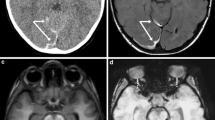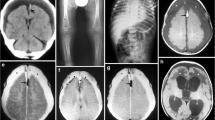Abstract
Background
Abusive head trauma (AHT) in young children usually has a severe outcome when associated with hypoxic-ischemic encephalopathy (HIE), which is best characterized by MRI in the acute or subacute phase utilizing diffusion-weighted imaging (DWI). HIE in this setting has been hypothesized to result from stretching of the spinal cord, brainstem, or vasculature.
Objective
To provide clinical correlation in patients with unilateral HIE and to postulate a mechanism in the setting of suspected AHT.
Materials and methods
IRB approval was obtained. Over a 5-year period, the medical records and images were reviewed of the 53 children ≤3 years of age who presented with acute head trauma according to the hospital registry. The children were subselected in order to determine how many suffered either HIE or AHT, and to detect those with unilateral HIE.
Results
In 11 of the 53 children, the etiology of the head trauma was highly suspicious for abuse. In 38 the head trauma was accidental and in 4 the trauma was of unknown etiology and at the time of this report was unresolved legally. Of the 53, 4 suffered HIE confirmed by CT or MRI. In three of these four with HIE the trauma was considered highly suspicious for AHT. Two of these three were the only patients with unilateral HIE, and both (7 months and 14 months of age) presented with early subacute phase HIE seen on DW MRI (range 4–7 days) and are described in detail with clinical correlation. The third child with AHT and HIE had bilateral findings. In the fourth patient the HIE was bilateral and was considered accidental. The work-up for both patients with unilateral HIE included head CT, craniocervical MRI, and craniocervical MR angiography (MRA). In both, there was mostly unilateral, deep white matter restricted diffusion, with subdural hematomas that were small compared to the extent of hypoxic-ischemic insult, and no skull fracture. Craniocervical MRA and axial thin-section fat-saturation images were negative for dissection, brainstem, or cord injury. Legal authorities obtained a confession of inflicted injury in one and a partial confession in the second (which did not fit the extent of injury). Five other children with HIE (based on DWI) were found during this period who had not suffered head trauma; all were bilateral insults.
Conclusion
HIE associated with AHT might present with largely unilateral white matter injury on DWI following extensive cortical infarction. We propose that unilateral HIE in a young child might be a sign of AHT and might result from cervical vascular compression, whether from kinking during hyperflexion/hyperextension or from direct strangulation.




Similar content being viewed by others
References
Commichau C (2003) Hypoxic-ischemic encephalopathy. In: Noseworthy J (ed) Neurological therapeutics: principles and practice (1st edn) Martin Dunitz, New York, pp 470–480
Hossmann KA, Hoehn-Berlage M (1995) Diffusion and perfusion MR imaging of cerebral ischemia. Cerebrovasc Brain Metab Rev 7:187–217
Biousse V, Suh DY, Newman NJ et al (2002) Diffusion-weighted magnetic resonance imaging in shaken baby syndrome. Am J Ophthalmol 133:249–255
Parizel PM, Ceulemans B, Laridon A et al (2003) Cortical hypoxic-ischemic brain damage in shaken-baby (shaken impact) syndrome: value of diffusion-weighted MRI. Pediatr Radiol 33:868–871
Grant PE, Yu D (2006) Acute injury to the immature brain with hypoxia with or without hypoperfusion. Radiol Clin North Am 44:63–77
James HE (1999) Pediatric head injury: what is unique and different. Acta Neurochir Suppl 73:85–88
Haviland J, Russell RI (1997) Outcome after severe non-accidental head injury. Arch Dis Child 77:504–507
Suh DY, Davis PC, Hopkins KL et al (2001) Nonaccidental pediatric head injury: diffusion-weighted imaging findings. Neurosurgery 49:309–318
Kawahara H, Takeda Y, Tanaka A et al (2000) Does diffusion-weighted magnetic resonance imaging enable detection of early ischemic change following transient cerebral ischemia? J Neurol Sci 181:73–81
Wijdicks EF, Campeau NG, Miller GM (2001) MR imaging in comatose survivors of cardiac resuscitation. AJNR 22:1561–1565
McKinney AM, Teksam M, Felice R et al (2004) Diffusion-weighted imaging in the setting of diffuse cortical laminar necrosis and hypoxic-ischemic encephalopathy. AJNR 25:1659–1665
Shannon P, Becker L (2001) Mechanisms of brain injury in infantile child abuse. Lancet 358:686–687
Shannon P, Smith CR, Deck J et al (1998) Axonal injury and the neuropathology of shaken baby syndrome. Acta Neuropathol 95:625–631
Geddes JF, Hackshaw AK, Vowles GH et al (2001) Neuropathology of inflicted head injury in children. I. Patterns of brain damage. Brain 124:1290–1298
Geddes JF, Vowles GH, Hackshaw AK et al (2001) Neuropathology of inflicted head injury in children. II. Microscopic brain injury in infants. Brain 124:1299–1306
Kemp AM, Stoodley N, Cobley C et al (2003) Apnoea and brain swelling in non-accidental head injury. Arch Dis Child 88:472–476
Ichord RN, Naim M, Pollock AN et al (2007) Hypoxic-ischemic injury complicates inflicted and accidental traumatic brain injury in young children: the role of diffusion-weighted imaging. J Neurotrauma 24:106–118
Vinchon M, Noule N, Tchofo PJ et al (2004) Imaging of head injuries in infants: temporal correlates and forensic implications for the diagnosis of child abuse. J Neurosurg 101:44–52
Keenan HT, Runyan DK, Marshall SW et al (2003) A population-based study of inflicted traumatic brain injury in young children. JAMA 290:621–626
Richards PG, Bertocci GE, Bonshek RE et al (2006) Shaken baby syndrome. Arch Dis Child 91:205–206
Petitti N, Williams DW 3rd (1998) CT and MR imaging of nonaccidental pediatric head trauma. Acad Radiol 5:215–223
Wilkinson WS, Han DP, Rappley MD et al (1989) Retinal hemorrhage predicts neurologic injury in the shaken baby syndrome. Arch Ophthalmol 107:1472–1474
Zimmerman J, Bilaniuk LT, Bruce D et al (1978) Interhemispheric acute subdural hematoma: a computed tomographic manifestation of child abuse by shaking. Neuroradiology 16:39–40
Nimkin K, Kleinman PK (2001) Imaging of child abuse. Radiol Clin North Am 39:843–864
Jaspan T, Griffiths PD, McConachie NS et al (2003) Neuroimaging for non-accidental head injury in childhood: a proposed protocol. Clin Radiol 58:44–53
Mackey M (2006) After the Court of Appeal: R v Harris and others [2005] EWCA crim 1980. Arch Dis Child 91:873–874
Geddes JF, Tasker RC, Hackshaw AK et al (2003) Dural haemorrhage in non-traumatic infant deaths: does it explain the bleeding in “shaken baby syndrome”? Neuropathol Appl Neurobiol 29:14–22
Christian CW, Taylor AA, Hertle RW et al (1999) Retinal hemorrhages caused by accidental household trauma. J Pediatr 135:125–127
Tung GA, Kumar M, Richardson RC et al (2006) Comparison of accidental and nonaccidental traumatic head injury in children on noncontrast computed tomography. Pediatrics 118:626–633
Caffey J (1972) Brain damage from whiplash-shaking of infants. Am J Dis Child 124:161–169
Duhaime AC, Gennarelli TA, Thibault LE et al (1987) The shaken baby syndrome: a clinical, pathological, and biomechanical study. J Neurosurg 66:409–415
Johnson DL, Boal D, Baule R (1995) Role of apnea in nonaccidental head injury. Pediatr Neurosurg 23:305–310
Ewing-Cobbs L, Prasad M, Kramer L (2000) Acute neuroradiological findings in young children with inflicted or non inflicted traumatic brain injury. Childs Nerv Syst 16:25–34
Huisman TA, Sorensen AG, Hergan K et al (2003) Diffusion-weighted imaging for the evaluation of diffuse axonal injury in closed head injury. J Comput Assist Tomogr 27:5–11
Arbelaez A, Castillo M, Mukherji SK (1999) Diffusion-weighted MR imaging of global cerebral anoxia. AJNR 20:999–1007
Chalela JA, Wolf RL, Maldjian JA et al (2001) MRI identification of early white matter injury in anoxic-ischemic encephalopathy. Neurology 56:481–485
Pantoni L, Garcia JH, Gutierrez JA (1999) Cerebral white matter is highly vulnerable to ischemia. Stroke 27:1641–1647
Field AS, Hasan K, Jellison BJ et al (2003) Diffusion tensor imaging in an infant with traumatic brain swelling. AJNR 24:1461–1464
Osborn AG, Blazer S, Salzman KL et al (2004) Diagnostic imaging: brain (1st edn), Amirsys, Salt Lake City, pp 38–41, 46–48
Geddes JF (2003) Comment. Apnoea and brain swelling in non-accidental head injury. Arch Dis Child 88:476
Alexander R, Sato Y, Smith W et al (1990) Incidence of impact trauma with cranial injuries ascribed to shaking. Am J Dis Child 144:724–726
Hadley MN, Sonntag VKH, Rekate HL et al (1989) The infant whiplash-shake injury syndrome: a clinical and pathological study. Neurosurgery 24:536–540
Pang D (2004) Spinal cord injury without radiographic abnormality in children, 2 decades later. Neurosurgery 55:1325–1342
Oelerich M, Stogbauer F, Kurlemann G et al (1999) Craniocervical artery dissection: MR imaging and MR angiographic findings. Eur Radiol 9:1385–1391
Goldsmith W, Plunkett J (2004) A biomechanical analysis of the causes of traumatic brain injury in infants and children. Am J Forensic Med Pathol 25:89–100
Dijkhuizen RM, Knollema S, van der Worp HB et al (1998) Dynamics of cerebral tissue injury and perfusion after temporary hypoxia-ischemia in the rat: evidence for region-specific sensitivity and delayed damage. Stroke 29:695–704
Oertel M, Boscardin WJ, Obrist WD et al (2005) Posttraumatic vasospasm: the epidemiology, severity, and time course of an underestimated phenomenon: a prospective study performed in 299 patients. J Neurosurg 103:812–824
Care M (2006) Neuroradiology. In: Frasier L, Rauth-Farley K, Alexander R et al (eds) Abusive head trauma in infants and children: a medical, legal, and forensic reference. GW Medical Publishing, St. Louis
Teixeira J, Zimmerman RA, Haselgrove JC et al (2001) Diffusion imaging in pediatric central nervous system infections. Neuroradiology 43:1031–1039
Kim JA, Chung JI, Yoon PH et al (2001) Transient MR signal changes in patients with generalized tonicoclonic seizure or status epilepticus: periictal diffusion-weighted imaging. AJNR 22:1149–1160
Wall CJ, Kendall EJ, Obenaus A (2000) Rapid alterations in diffusion-weighted images with anatomic correlates in a rodent model of status epilepticus. AJNR 21:1841–1852
Takahashi S, Higano S, Ishii K et al (1993) Hypoxic brain damage: cortical laminar necrosis and delayed changes in white matter at sequential MR imaging. Radiology 189:449–456
Sener RN (2004) Diffusion magnetic resonance imaging patterns in metabolic and toxic brain disorders. Acta Radiol 45:561–570
Author information
Authors and Affiliations
Corresponding author
Rights and permissions
About this article
Cite this article
McKinney, A.M., Thompson, L.R., Truwit, C.L. et al. Unilateral hypoxic-ischemic injury in young children from abusive head trauma, lacking craniocervical vascular dissection or cord injury. Pediatr Radiol 38, 164–174 (2008). https://doi.org/10.1007/s00247-007-0673-0
Received:
Revised:
Accepted:
Published:
Issue Date:
DOI: https://doi.org/10.1007/s00247-007-0673-0




